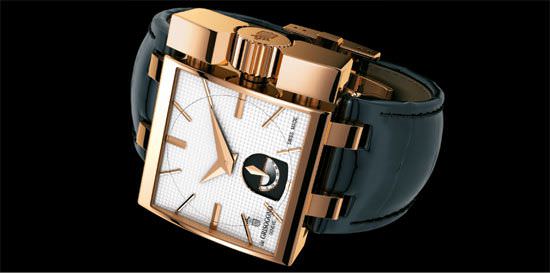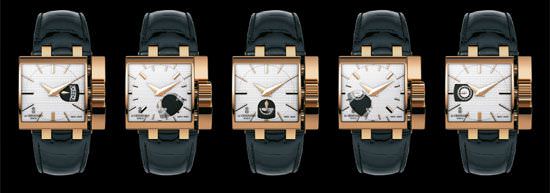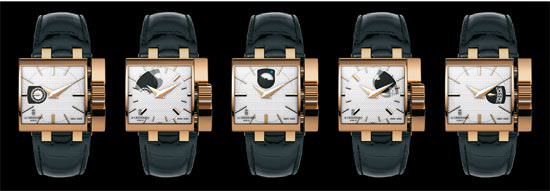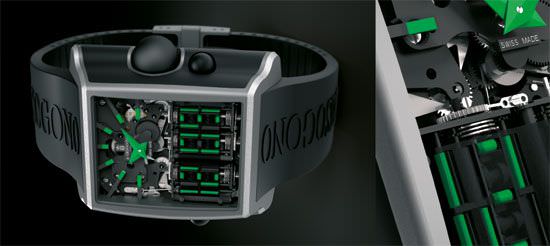We all know that Fawaz Gruosi is a past master in the art of producing the most glamorous festivities in the watch world, and his repu-tation certainly continued with the organiz-ation of three days of grandiose events in Geneva, to which all, or nearly all, members of the global watch press were invited.
We also know that Gruosi is quite adept at proposing surprising, innovative, and very contemporary types of watchmaking, as seen for example in the Occhio model. With this timekeeper, he has brilliantly demonstrated that the de Grisogono brand has become a full-fledged member of the club for elite mechanical watchmaking. In quick succession, one night after the other, the brand presented two astonishing pieces that have reinvented, each in its own fashion, the art of displaying time.
The Otturatore
Let’s begin with the brand’s more ‘classic’—in appearance only—timekeeper called the Otturatore.
The traditional placement of displays on a normal watch’s single dial demonstrates at first glance the complexity of the piece but it also (and importantly) presents a sizeable dilemma: the ease of readability. We have all strained our eyes trying to read a given dial or some microscopic indication in a sub-dial. Well, the Otturatore splendidly solves this problem by ‘simply’ displaying the various indications—concealed under the tasteful Clou de Paris dial—not in a simultaneous manner, but one after the other, in a sort of sequential display.

Thus, a simple press of about a millimetre on one of the large pushbuttons located on the side of the off-centred case allows for the display, each in its own turn, of the seconds, date, lunar phase, and power reserve. The mobile (or sequencer) dial, in which an opening has been placed, moves 90 degrees in just a few tenths of a millisecond to position itself before the following display.
To obtain this speed, 15 dynamic functions (command, coupling, decoupling, mechanical memory, gearing, etc.) all come into play quasi-instantaneously. The development of this mechanism (composed of 100 component parts, and whose power reserve is assured by a specific barrel integrated into the module) required the use of simulation techniques and advanced numerical calculations utilizing software borrowed from automobile and aeronautical research laboratories.
As Fawaz Gruosi explains, “The complexity of the movement creates antagonisms similar to a car that instantly accelerates to its maximum speed only to immediately brake and stop on a predefined arrival line with absolute precision.” Does this mean, as Gruosi affirms, that it is “the initial development in a new generation of timekeepers,” and that the mobile sequencer is the prelude to other applications “likely to dramatically redraw the landscape of the watch complication?”


Does this very ingenious method of displaying the various functions foreshadow the beginning of a new design, mid-way between classical tradition—rectangular red gold curved case, guillochÉ opaline dial, and elegant dauphine hands—and transgression, with its off-centred case allowing for two large rectangular pushbuttons, and blackened finishing on the movement that is visible through the transparent caseback?
The Meccanico dg
The second watch presented by de Grisogono, the Meccanico dg, is perhaps even more impertinent in its approach. Beneath its appearance as a luxurious super play thing for the big boys, it is a watch that “really opens up new horizons,” according to Fawaz Gruosi.
It is the first totally mechanical watch to feature a double analogue and digital display. (The Harry Winston Opus III by Vianney Halter is also a digital mechanical timepiece but it is not yet available in the marketplace, and the Jean Dunand brand’s Shabaka model has a digital display and date that are achieved using rollers.) The Meccanico dg is an absolutely fascinating object. It has only one movement, a manual winding calibre that powers two time zones. The first is displayed in the traditional manner using hands, but the second, in the lower zone, offers a digital display indicating the hours and minutes in divisions of 12 utilizing a group of mobile micro segments (for example, the AM/PM display goes from 0.0 to 12.59). The mobile horizontal and vertical micro segments compose digital numbers that are entirely mechanical but which seem to be drawn from early quartz movements. There are 23 tiny segments that measure 9mm in height (and weigh 25 milligrams) for the vertical segments, and 2.9mm (and weigh 10 milligrams) for the horizontal segments.

Each presents four faces, of which the two opposites are equipped with colour plates (green in the titanium version, and gilded in the pink gold version). The other two faces are ‘invisible’ since they have been blackened like the elements that surround them. The time indications are achieved by an instantaneous and simultaneous rotation of 90 degrees by a dozen segments, according to which hour is displayed.
Quite understandably, this is a very complicated mechanical timepiece, whose movement is constructed of 651 component parts. The system of cams and gears that drive the digital display is visible through the transparent dial, giving the impression that the upper part of the movement, supporting the coloured indices, seems to be floating in a void. The power reserve of this futuristic and very haut de gamme toy is 35 hours, a relatively good performance considering the amount of energy required to maintain a double display and the indispensable torque necessary for the rotation of the micro segments. The power reserve indicator is visible on the back of the watch, through the transparent and curved sapphire crystal caseback.
This ultra modern piece features an imposing curved case (56mm x 48mm) made of a choice of pink gold, titanium, titanium and pink gold, titanium and rubber, or titanium and platinum (in total, the series is limited to 177 pieces), making it completely in keeping with its innovative character. A rubber ball covers the crown, located at 3 o’clock, which is used to set the analogue display, as are two correctors that allow the user to set the hours, on the left, and the minutes, on the right. Meccanico dg is an exceptional ‘talking piece’ presented at BaselWorld.
For further information, please click on Brand Index at www.europastar.com
Source: Europa Star April-May 2008 Magazine Issue





